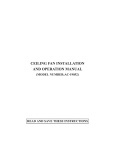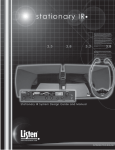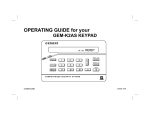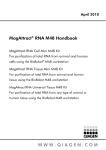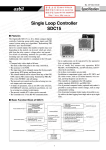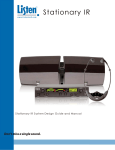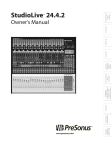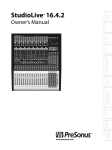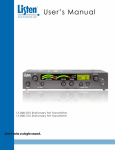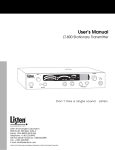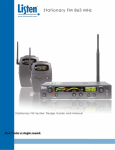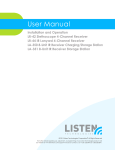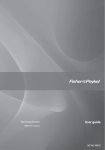Download User Manual - Listen Technologies
Transcript
User Manual Installation and Operation LT-82 Stationary IR Transmitter LA-140 Stationary IR Radiator © 2015 Listen Technologies Corporation® All Rights Reserved For further details regarding use, adjustment, or programming of your Listen Technologies products visit our website at www.listentech.com/support-manuals or contact us at +1.801.233.8992 or 1.800.330.0891. l 1 Stationary Infrared Table of Contents 2 l Design Guide Infrared Technology Overview System Overview Designing a System Design Tools 3 5 7 17 LT-82 Stationary IR Transmitter Specifications Block Diagram Quick Reference Page Setup and Operating Instructions Accessories for LT-82 23 24 25 26 31 LA-140 IR Radiator Specifications Quick Reference Page Setup Instructions LED Indications Mounting your Radiator Accessories for LA-140 33 34 35 36 38 58 Infrared Technology Overview Infrared or “IR” technology uses infrared light to transmit audio without wires. This type of transmission is advantageous to RF transmission because it is secure, it is not susceptible to RF interference, and one receiver can be used for multiple rooms within a facility. The transmitter accepts an audio signal and then frequency modulates an RF carrier at 2.3, 2.8, 3.3, and/or 3.8MHz. This carrier along with DC power (to power the radiator) is supplied to the radiator via cables. The carriers are then radiated into the room using IR emitter diodes. This is the same technology used by the remote control of your TV set. A receiver then receives the IR light and demodulates the carrier. 1 2 3 4 Radiator Audio Source IR Transmitter Receiver When designing an IR system it is important to keep the following in mind: • In open space (when there are no reflective surfaces) IR is line of sight. If the receiver cannot “see” light from the radiator, it will not receive the audio signal. It is important to provide sufficient IR coverage within a facility, so users will not have drop outs of the IR signal. This design guide will help you do this. • In facilities that have reflective and lighter colored surfaces, the IR light will be reflected and you can achieve greater coverage. For example, when emitting in a very large room (like an exhibit hall) you will notice that you need to point the receiver directly at the radiator to pick up the signal. However, when the radiator is placed in a smaller room (for example 50 ft2/14.6 m2 square) with white walls you will experience much better coverage. This is because the IR signal is being reflected in many different directions, increasing coverage. • Listen Technologies systems use higher modulation frequencies that make the system less susceptible to light interference from fluorescent lights and other sources. However, the system is not immune from interference from sources that create IR light such as sunlight and plasma displays. • Listen Technologies products are compatible with other manufacturers who use the same modulation frequencies (2.3, 2.8, 3.3, 3.8 MHz). l 3 System Overview There are three main components of any Stationary IR system: the transmitter, radiator (emitter), and receivers. LT-82 Transmitter LA-140 Radiator 1 2 3 1 4 1 2 3 2 LR-42 3 4 1 4 2 3 4 LR-44 LR-4200-IR Intelligent DSP IR Receiver LR-5200-IR Advanced Intelligent DSP IR Receiver Single Channel System A single channel system consists of one LT-82 transmitter and one or more radiators. The diagram below shows such a system with one radiator. The radiator is powered from the power supply at the transmitter. This power supply can supply enough power for the LT-82 and up to two LA-140 radiators. If you need more than two radiators, you will need more power supplies. This is discussed later in this document. Power is supplied from standard CAT-5 cable while RF from the transmitter is delivered using 50-ohm RG-58 coaxial cable. The radiator is supplied with 25 feet (7.6 meters) of CAT-5 and RG-58 coaxial cable. LA-140 IR Radiator LT-82 Stationary IR Transmitter 1 LA-140 IR Radiator 4 IR 2 1 3 4 LR-42 IR Stetho Receiver Power – CAT-5 Cable RF – RG-58 50 ohm Cable 3 LR-42 IR Stetho Receiver Power – CAT-5 Cable LT-82 Stationary IR Transmitter RF – RG-58 50 ohm Cable 2 Mounting hardware for radiator included with radiator IR 1 2 3 4 LR-44 IR Lanyard Receiver Mounting hardware for radiator included with radiator LR-4200-IR Intelligent DSP IR Receiver 4 l LR-5200-IR Advanced Intelligent DSP IR Receiver 1 2 3 4 LR-44 IR Lanyard Receiver System Overview Multiple Channel System A multiple channel system consists of two to four LT-82 transmitters and one or more radiators. The diagram below shows such a system with two radiators. The radiators are powered from the power supply from the first transmitter. This power supply can supply enough power for the LT-82 and two LA-140 radiators. If you need more than two radiators, you can use the power from the other transmitters. In this example, the four transmitter power supplies can supply enough power for up to eight LA-140 radiators. This is discussed later in this document. Power is supplied from standard CAT-5 cable while RF from the transmitter is delivered using 50-ohm RG-58 coaxial cable. Each radiator is supplied with 25 feet (7.6 meters) of CAT-5 and RG-58 coaxial cable. Up to four LT-82 transmitters can be daisy chained together (using RG-58 cable) to create a multi-channel system Up to 100 LA-140 radiators can be daisy chained together (using RG-58 cable) to provide sufficient IR power for most applications LA-140 IR Radiator Power – CAT-5 Cable IR RF – RG-58 50 ohm Cable 2 1 3 4 LR-42 IR Stetho Receiver LT-82 Stationary IR Transmitter RF – RG-58 50 ohm Cable LA -89 RG-58 Multi-carrier Interconnection Cable (included) Power – CAT-5 Cable IR LT-82 Stationary IR Transmitter 1 2 3 4 LR-44 IR Lanyard Receiver LA-140 IR Radiator LT-82 Stationary IR Transmitter Radiator Power: Radiators can be powered from the LT-82 (up to two radiators) or an additional power supply (LA-205) can power up to two radiators Radiator RF: RF from the last LT-82 must be daisy chained from radiator to radiator LT-82 Stationary IR Transmitter LR-4200-IR Intelligent DSP IR Receiver LR-5200-IR Advanced Intelligent DSP IR Receiver l 5 System Overview Key Concepts of Designing a Stationary IR System 1 Each LT-82 transmitter used can power two LA-140 radiators 2 Up to four LT-82 transmitters can be interconnected to create up to a four channel system Each LT-82 transmitter used can power up to two LA-140 radiators. If you design a system that requires more radiators than the transmitters can power, you need to order additional LA-205 power supplies. Each LA-205 can power up to two LA-140 Radiators. Up to four LT-82 transmitters can be interconnected to create up to a four channel system. For the system, there are two RF outputs provided for connection to the radiators. Each of these two outputs is referred to as the “Radiator Daisy Chain.” RG-58 coaxial cable is used to interconnect the RF in the radiator daisy chain. You can connect as many radiators in the daisy chain as you need. NOTE: Adding additional transmitters will decrease radiator coverage. 3 Each radiator requires one RF (RG-58 coax) connection and one power (CAT-5) connection Each radiator requires one RF (RG-58 coax) connection and one power (CAT-5) connection. The RF connection can come from a transmitter or from another radiator. The power connection can come from either a transmitter, a radiator or from a power supply (as long as you don’t exceed the capacity). 4 Listen Technologies has provided mounting hardware for most LA-140 mounting situations To make it easy for you to design, specify and install a system, Listen Technologies has provided mounting hardware for most mounting situations including wall, ceiling, corner, desk, tripod and mic stands. To double the radiation power you can vertically or horizontally mount two radiators together using the LA-342 dual radiator mounting brackets. This includes coaxial RF and CAT-5 power cables. 6 l 5 It is possible that the RF signal arrives to different radiators at different times 6 As the number of channels increases, the effective radiated coverage declines 7 The coverage patterns provide coverage of the system assuming no reflection 8 The maximum length of CAT-5 power cable 9 The maximum length of coaxial RF cable Due to the higher modulation frequencies, it is possible that the RF signal arrives to different radiators at different times. This delay can cause the IR carriers to add “out of phase” and cause the signal to drop out. To solve this problem, Listen Technologies has provided a delay compensation adjustment on each radiator. This design guide will help you calculate the setting for this adjustment. As the number of channels increases, the effective radiated coverage declines. For example, a two channel system will have half the coverage of a single channel system. If is important to increase the number of radiators for multiple channel systems. The coverage patterns provided by Listen Technologies provide coverage of the system assuming no reflection. In addition, the radiator has been under-rated to account for system degradation as the IR emitting LEDs age over time. It is important to design the system based on these coverage patterns and not by trial and error. The reason for this is that the coverage pattern will be stronger when the radiator is new. A system that has adequate coverage today may not have adequate coverage in the future if not designed according to the specified coverage patterns of the radiator. CAT-5 power cable should never exceed 250 feet when powering two (2) LA-140’s from an LT-82 or 700 feet when powering one (1) LA-140 from an LT-82. Coaxial RF signal cable should never exceed 1000 feet from the source transmitter. Designing a System 1 Determine the number of audio channels 2 Determine the room size and shape 3 Complete the room layout worksheet You will need to order one LT-82 transmitter for each audio channel. The Listen system can deliver up to four audio channels simultaneously. You should either measure the room or use the architect’s plans to obtain this information. Complete the room layout worksheet found in the final section of this guide placing the location of the transmitters, power supplies and radiators using the worksheet key. The following factors will determine the coverage of the room. 3A Number of radiators and location Except in small rooms it is recommended that at least two radiators be used to ensure good coverage and minimal shading. Listen Technologies radiators (when used with Listen Technologies ’ LR-42 and LR-44 receivers) will cover approximately 10,000 ft2 (929 m2) for one channel as indicated in the diagram below (note the coverage decreases as the number of channels goes up). For two channels, one radiator will cover 5,000 ft2 (465 m2) and for four channels, one radiator will cover 2,500 ft2 (232 m2). When using LR-4200-IR/LR-5200-IR receivers, the approximate line-of-sight coverage increases to 40,000 ft2 (3716 m2) for one channel. Horizontal Plane Footprint Pattern (feet) 50 40 30 20 10 Coverage pattern shown in feet 4 TX 0 2 TX 1 TX 10 20 30 40 50 0 10 20 30 40 50 60 70 80 90 100 110 120 130 140 150 You should use the above coverage pattern to determine coverage of each radiator in your system, not by trial and error. The radiator will be stronger when new and therefore is under-rated by 40 percent and the coverage pattern above accounts for this. 40 percent degradation will occur after approximately 8,000 operating hours. l 7 Designing a System Horizontal Polar Pattern Single Channel System Vertical Polar Pattern Single Channel System 8 l Designing a System It is a good idea to provide over-lapping coverage (like in a sprinkling system) of the signal whenever possible to ensure that the signal does not have drop outs. In addition, you should provide special radiator coverage for shaded areas such as under a balcony or in the front of a room where the front mounted radiators do not provide enough coverage. The following diagrams illustrate these concepts. In this example a total of four radiators, one in each corner, ensures good coverage at all locations and orientations. Except in small rooms, it is recommended that at least two radiators are used to prevent shading of the IR signal. l 9 Designing a System If there is an area within a room (such as under a balcony) that is shielded from the main radiation pattern, you will need to provide additional radiator(s) to cover this area. 10 l Designing a System To double the radiator power, it is possible to vertically or horizontally mount two radiators together using the LA-342 Dual Radiator Mounting Bracket (sold separately). This is highly recommended in larger rooms. RAD 1 RAD 2 3B Height of Radiators It is critical to mount the radiators at the proper height. If the radiator is mounted too low, the coverage pattern will be too small to provide sufficient long throw coverage. If the radiator is mounted too high the required angle of the radiator will cause the radiation pattern to be compromised. The best height of the radiator is about 16 ft2 (5 m2) from the floor. 3C Radiator Mounting Angle The mounting system for Listen Technologies LA-140 radiators allow you to mount the radiator in 15 degree increments. The best angle depends on the shape of the room and the orientation of the radiator to the seats within the room. In general, mounting angles of 15 and 30 degrees provide the best coverage. l 11 Designing a System 4 Determine the number of radiators required Determine the number of radiators required based on the size and shape of the room. Based on step two, it is recommended that you draw the room out indicating the location of each radiator in the room and cable runs from the transmitter(s) and power supplies (if any) to the radiator. We have provided the room layout worksheet for you to do this towards the back of this design guide. See example below: 12 l Designing a System 5 Complete the system layout worksheet Complete the system layout worksheet for Power and RF cable lengths, delay compensation, required number of power supplies, and height and angle of radiators. Refer to the system layout worksheet example below. l 13 Designing a System 5A Cross out the LT-82 transmitters Cross out the LT-82 transmitters not required in your system. 5B Determine how many radiators will be used Determine how many radiators will be used on each radiator daisy chain by reviewing the room layout worksheet. Cross out the unused radiators on the system layout worksheet. 5C Write in the coaxial RF cable lengths for each radiator Write in the coaxial RF cable lengths for each radiator used in the spaces provided. Review your room layout worksheet for this information. 5D Draw a connecting line from the power supply output Draw a connecting line from the power supply output of the LT-82 transmitter(s) and the LA-205 power supplies to each of the radiators. Keep in mind that each transmitter and power supply can power up to two LA-140 radiators. 5E Cross out the unused power supplies Cross out the unused power supplies. 5F Write in the CAT-5 power supply cable lengths Write in the CAT-5 power supply cable lengths for each radiator used in the spaces provided. Review your room layout worksheet for this information. 5G Determine the delay compensation for each radiator Now determine the delay compensation for each radiator using the Delay Compensation Calculator located in the back of this design guide. The correct setting of the delay compensation is necessary only in systems where there is overlap in coverage between two or more radiators. Write the delay setting on the System Layout Worksheet. The delay setting for each radiator is determined using the calculator and as follows: 1 Distance of Furthest Radiator (DFR) Determine which radiator is the furthest from the transmitter on one of the two daisy chains. Calculate the distance from the furthest radiator to the transmitter and record it in the first column of the delay compensation calculator. See example below. 2 Radiator Distance from Transmitter (RDT) For each radiator, determine the overall distance from the transmitter to the radiator. Record the value of each radiator in the RDT column. See example below. 3 Cable Delay (CD) Determine and record the propagation delay of the coaxial cable being used. For Listen coaxial cable the delay is 1.54 ns/ft or 5.05 ns/m. This information can be obtained from the specification sheets supplied by the cable manufacturer. 4 Calculate the delay setting for each radiator Now calculate the delay setting for each radiator using the Delay Compensation Calculator. The calculator uses the following formula to determine the delay setting of each radiator: Delay Setting = (DFR – RDT) x CD / 25 NOTE: If your calculations suggest a delay setting greater than nine, please contact Listen Technologies tech support for more information. 1.801.233.8992 [email protected] 14 l Designing a System 6 Complete the system materials worksheet Complete the system materials worksheet that determines the quantity of each part number required for your system. Use the Room and System Layout Worksheets to fill in this form found in the last section of this guide. 6A Transmitters Fill in the number of transmitters required. Each transmitter includes a short piece (15 inches) of RG-58 coaxial RF cable for multiple channel installation interconnections. You do not need to order this cable. 6B Transmitter Rack Mounting Fill in the number of rack mounting kits required. One rack mount kit can mount two LT-82 transmitters. 6C Radiators Fill in the number of each type of radiator required. Each radiator comes with mounting brackets for most types of installation. In addition, the radiator comes with 25 ft (7.6 m) of coaxial RF and CAT-5 power cables. l 15 Designing a System 6D Radiator Mounting Options Since the radiator comes with most radiator mounting options, there are only two additional choices. 1 Dual radiator mounting The LA-342 dual radiator mounting bracket allows you to mount two radiators together (vertically or horizontally). This includes short lengths of coaxial RF and CAT-5 power cables. 2 Floor stand The LA-337 is a floor stand for portable applications. 6E Radiator Power Supplies Fill in the number and type of LA-205 power supplies required (if any). 6E Cables From the System Layout Worksheet, insert the cable lengths for the preassembled coaxial RF cables (LA-391) and CAT-5 power cables (LA-393). 6F Other Accessories For US customers, Listen Technologies offers the ADA Compliance Signage Kit (LA-304). This aids in complying with US ADA regulations. 16 l l 17 KEY KEY CAT-5 RG-58 CAT-5 RG-58 LA-140 LT-82 LA-140 LT-82 Room Layout Worksheet System Layout Worksheet 18 l l 19 20 l System Materials Worksheet Stationary IR Transmitter Transmitters Power Cord Part Number USA UK Euro LT-82-01 LT-82-02 LT-82-03 Quantity Universal Rack Mount Kit (Mounts two LT-82 units) Transmitter Rack Mounting Part Number LA-326 Quantity Radiators Color Part Number Stationary IR Radiator Grey White LA-140-GY LA-140-WH Dual Radiator Mounting Bracket IR Radiator Floor Stand LA-342 LA-337 Quantity Radiator Mounting Options Part Number Quantity IR System Power Supply Radiator Power Supplies Required Power Cord Part Number USA UK Euro LA-205-01 LA-205-02 LA-205-03 Quantity Cables (length in feet) BNC/RG-58 Coaxial Cable Preassembled (RF) RJ-45/CAT-5 Cable Preassembled (Power) Part LA-391 LA-393 Number Cable 1 Cable 2 Cable 3 Cable 4 Cable 5 Cable 6 Cable 7 Cable 8 Cable 9 Cable 10 Cable 11 Cable 12 Note: Each radiator includes 25 feet (7.6 meters) of RG-58 coaxial RF cable and CAT-5 power supply cable. l 21 LT-82 Package Contents • LT-82 IR Transmitter • LA-205 Power Supply • LA-89 IR Interconnection Cable • IR System Design Guide and User’s Manual • LT-82 Quick Reference Card LT-82 IR Transmitter LA-89 IR Interconnection Cable LA-205 Power Supply Listen Configurations • LT-82-01 (North America) • LT-82-02 (UK) • LT-82-03 (Euro) 22 l LT-82 Specifications Architectural Specification The Stationary IR Transmitter shall be capable of broadcasting on four mono or stereo carriers: 2.3, 2.8, 3.3, and 3.8 MHz. Channel selection shall be capable of being locked. Multiple transmitters shall be capable of being daisy chained together to transmit up to four channels simultaneously. The transmitter shall have a timer that shuts off the carriers after 30 minutes when no audio is present at the transmitter. The transmitter shall have a SNR of 60 dB or better. The device shall have an audio frequency response of 63 Hz to 15 kHz, +/- 3db. It shall have two mixing audio inputs, one balanced XLR/phone input and one unbalanced RCA input. The device shall have the following audio controls: input level, transmit level, contour level and stereo on/off control. The device shall have an audio processor that is capable of automatic gain control and limiting. The transmitter shall provide power for up to two radiators over CAT-5 cable. The LT-82 is specified. Specification Carrier Frequencies Number of Channels Carrier Shut Off0 RF Frequency Accuracy Transmitter Stability RF Output RF Input Compliance Audio ** All system specifications are wireless end-to-end System Frequency Response 63Hz - 15kHz (+/- 3dB) Mono: >60dB System Signal to Noise Ratio (A-weighted) Stereo: >52dB System Distortion <2% total harmonic distortion (THD) Mono Input (Rear Panel). Female-XLR and 1/4 in combo connector, balanced, 0/-55dBu (line/mic) nominal input level adjustable; -30/+21dBu (mic/line) Audio Input 1 maximum input level; impedance 20k/1k ohms (line/mic); phantom power +12VDC Stereo or Mono Input (Rear Panel). (Two) Phono connectors, unbalanced, Audio Input 2 -10/+10dBu nominal input level adjustable, +30dBu maximum, impedance 100k ohms Compression can be turned on/off. Slope adjustable from 1:1 to 4:1. Default Audio Processing 2:1 Contour Cuts and boosts frequencies above 5 kHz Input 1 and Input 2 Mixed Output (Rear panel). Two (2) Phono connectors, Combined Audio Output (Mix) unbalanced, -10dBu nominal output level, +19dBu maximum, impedance 10 ohms. Front panel. (One) 3.5mm connector, unbalanced, adjustable output level, Headphone Output (Monitor) +7dBu maximum, impedance 10 ohms. 100mW, 32 ohms, 3.5mm stereo. Front Panel Controls Rear Panel Internal Adjustments Programming Unit Power Input 1, Input 2, Transmit Level Indicators Stereo Processing RF Carrier LCD Display Test Tone Power Supply Power Power Output: Physical LT-82 Selectable: 2.3 MHz, 2.8 MHz, 3.3 MHz, 3.8 MHz Four channels. Selectable one channel per transmitter (mono or stereo) Carrier will shut off when no audio is present for 30 minutes to preserve radiator life. +/- .005% stability 0 to 50C 50 PPM (Two (2) BNC connectors, for connection to radiator(s) and/or additional transmitter(s). 50 mV, 50 ohm, -15 dBm One (1) BNC connector, for connection from additional transmitter(s). 50 mV, 50 ohm, -15 dBm FCC Part 15, Industry Canada, CE, RoHS Power, Test Tone on/off, Channel up/down, Input Level, Transmit Level, Contour, Headset Level Input 1 Level (Line, Mic, Mic-Phantom Power), Input 2 Level (-10/+10 dBu) Compression ratio for audio processor Stereo on/off, Processing on/off Red LED illuminates when the unit is powered up (front panel) Indicates Input 1, Input 2, and Transmit audio levels. 10 segment LED’s (8 green, 2 red) Indicated by a green LED when on (front panel) Indicated by a green LED when on (front panel) Indicates carrier is active on the LCD Display (front panel) Channel designation, lock status, RF Carrier, programming (front panel) Red LED illuminates when test tone enabled (front panel) In-line switching mode power supply, Listen part number LA-205 Input: 100-240 VAC, 47-63 hz Output: 30 VDC, 1.5 A Output Connector: RJ-45 Compliance: UL and CE Listed Two (2) RJ-45 jacks. For remote powering up to 2 radiators. North America, Type B, (LT-82-01) Power Line Cord Asia, UK, Type G, (LT-82-02) Euro type J, (LA-82-03) Dimensions (H x W x D) Color Unit Weight Unit Weight with LA-205 Power Supply Shipping Weight 1.75 x 8.50 x 9.13 in. (4.5 x 21.5 x 23 cm) Grey with White Silk Screening 2.6 lbs. (5.7 kg) 3.8 lbs. (8.3 kg) 4.4 lbs. (9.7 kg) One rack space height, 1/2 rack space wide. One or two transmitters can be mounted in one rack space. Optional rack mount (LA-326) not included. Rack Mounting l 23 LT-82 Block Diagram POWER 3.5MM Stereo On Off Red LED 115/230VAC 50/60hz Universal Power Supply LA-205 (provided) CHANNEL SELECT HEADPHONE Up Volume 30VDC, 1.5A Down Power Supply CPU Module Automatic Overload Protection Terminal CAT5 Transmit Level Meter Listen LCD Display Backlit DC Out Compression Ratio (internal adjustment) RF IN Transmitter RF Board Stereo Generator Pre-emphasis Processing OUT BNC Green LED Transmit LEVEL Off On Green LED CONTOUR On Functions controlled by the CPU Module PROCESS STEREO Input 1 VU Meter Off Input 2 VU Meter Input Level POT Front Panel 12VDC Mic Phantom Pwr Mic Line Input 1 Level Select Line, Mic, Mic -phantom Pwr Input 2 Level Select -10dBu, +10dBu Test Tone Button Front Panel +10 -10 +10 Off -10 On Red LED 400Hz TEST TONE Female XLR-1/4” Combo Connector 2/Tip 3/Ring INPUT 1 Mono Only 1/Sleeve Phono Phono INPUT 2 Mono/Stereo 24 l Phono OUTPUT Mono/Stereo LT-82 Quick Reference Transmit Level Indicator: Shows mixed audio level Process LED: Indicates audio processing mode is active Stereo LED: Indicates stereo mode is active Input Level Indicators: Shows Input 1 and Input 2 levels. Input 1 and 2: Adjust audio input levels of Input 1 and Input 2 here LCD Display: See LCD Display quick reference Monitor Jack: Plug in a headset to monitor audio Power: ON/OFF Test Tone: Activates a tone to aid system setup Channel Select Up and Down: Use to select channel. Buttons also used for programming functions Contour: Equalization adjustment; boosts or cuts high frequencies Transmit Level: Adjusts mixed audio levels RF Input: Input additional RF signal here for multi-channel systems Input 1: Balanced input for connection of a line level or microphone; accepts either a XLR or ¼” phono plug RF Outputs: Output RF signal to radiator(s) and/ or additional LT-82 Input 1 Level Switch: Set switch for line or mic level. Phantom power available in Mic-PH Power position Input 2 Level Switch: Set switch to match the level of your Input 2 source Power Input: Connect power supply here (included) Input 2: Audio inputs; stereo or mono Audio Outputs: Input 1 and Input 2 mixed audio outputs Power Outputs: Can be used to power up to two radiators Channel Display: Displays what channel the LT-82 is currently on RF output indicator: Indicates transmitter is outputting RF Program Mode: Indicates the unit is in program mode Lock Icon: Indicates the unit is locked on current channel l 25 LT-82 Setup and Operating Instructions 1 Unpack the Product 2 Mount LT-82(s) in Rack (if desired) Remove outer packaging and plastic cover. Verify all components are present and no physical damage has occurred to the product. If rack mounting the transmitter(s), install the optional rack mount kit (part LA-326) according to the instructions included with the kit. Rack Mount with single unit installed. 3 Rack Mount with dual units installed. Interconnect Multiple LT-82s (if necessary) If installing more than one transmitter (for multi-channel applications), it will be necessary to daisy chain the transmitters. Connect RF output on first transmitter to RF input on second transmitter. Continue daisy chaining up to four transmitters (four channels). 4 Connect LT-82 RF Signal to Radiator(s) Connect RF output on transmitter to RF input on radiator. In multi-channel systems connect the last transmitter in the daisy chain to the radiator(s) RF input. See design guide for more information on connecting multi-channel systems. RF Signal on coaxial cable 26 l LT-82 Setup and Operating Instructions 5 Connect LT-82 Power to Radiator(s)(if desired) The radiator(s) can be powered by either the transmitter Power Output or remotely with a power supply (LA-205) near the radiator. If powering the radiator(s) with the transmitter, connect the transmitter Power Output to the radiator Power Input with CAT-5 cable. NOTE: A maximum of two radiators can be powered by each LT-82. It is important not to exceed powering more than two radiators per transmitter or external power supply. RF Signal on coaxial cable 6 Powering the LT-82 radiator power on CAT-5 cable 6A Plug the included power supply into the Power Input connection Plug the included power supply into the Power Input connection on the rear panel of the transmitter, and then plug the power supply into an outlet. ATTENTION: Do not connect the LT-82 power supply to an outlet until all other power connections within the system have been made. This helps to prevent power connection degradation. 6B Press the Power button Press the Power button on the front panel of transmitter(s) to turn the unit(s) on. RF Signal on coaxial cable Be sure to plug into LT-82 before connecting to power outlet radiator power on CAT-5 cable TX power cable l 27 LT-82 Setup and Operating Instructions 7 Select Operating Channel 7A Select the operating channel Select the operating channel (1-4). For single channel systems any channel can be used. In multi-channel systems each transmitter must be on a different channel. Down Button Channel select buttons Up Button 7B RF-Off Channel Setting Information This channel does not have a carrier present however allows pass through from RF input to RF output. This allows a channel to be disabled in a daisy chain but allows the system to still operate as the RF signal from the transmitter(s) before it will still pass through. Note that the power (RJ-45 with CAT-5 connectors) will pass through in all conditions (unit off, channel -- or channels 1-4). RF-Off Channel Setting 7C After channels have been selected, the transmitter(s) can be locked After channels have been selected, the transmitter(s) can be locked on that channel by pressing and holding the Channel Select Up button for three seconds. When locked, a padlock icon will be displayed on the LCD (see below). Icon indicates channel is locked 28 l LT-82 Setup and Operating Instructions 8 Connect Audio Inputs The LT-82 has two audio input options: Input 1 and Input 2. Input 1 is a balanced connection using either an XLR or 1/4” phono connector. Input 2 has two unbalanced mixing phono connectors. Use Input 1 if you are using a microphone or if you have a balanced connection such as from a professional audio mixer (you can also use Input 1 for unbalanced connections). Use Input 2 to connect to an unbalanced audio source. 8A If using Input 1 Connect the audio source(s) to one or both audio input connections. Input 1 offers a choice of balanced XLR or 1/4” phono connector. Plug your microphone into Input 1 and move the input select switch to Mic (for dynamic microphones) or Mic + PH Power (for condenser microphones). Plug your balanced or unbalanced audio source into Input 1. Use the following diagram. XLR Wiring 1/4”Phone Wiring Balanced Unbalanced Tip Ring Sleeve Sleeve Input from Balanced Audio Source Top Ring Unbalanced Audio Source Top Ring/Sleeve Audio from Balanced Audio Source Unbalanced Audio Source 8B If using Input 2 Plug your unbalanced audio source into Input 2 and select the audio level switch for -10dBu or +10dBu, to match the audio level coming from your equipment. ATTENTION: When using Input 1 and Input 2 simultaneously, the audio signals will mix together. Input 1 will mix with both left and right signals of Input 2. 8C Test Tone (if necessary) To broadcast a test tone, press the test tone button. This helps to test receivers when no audio source is available. l 29 LT-82 Setup and Operating Instructions 9 Set Stereo and Process Features 9A Stereo and Process Mode Descriptions 1 Stereo Mode A stereo signal can be transmitted to the receivers. Input 2 must be used if a stereo signal is desired and the stereo mode must be enabled on the transmitter. ATTENTION: I f the transmitter is in stereo mode the receivers will need to be put into stereo mode. Refer to the appropriate receiver manual for more information. 2 Process Mode Process mode is used for Audio Gain Control (AGC). With the process mode enabled, the LT-82 will automatically adjust for inconsistent signal input levels by raising or lowering the signal level accordingly to provide a consistent sound output level. This feature should be used in applications where a consistent sound level is important and the input levels vary substantially. Typically you would not want to engage the Process Mode when a speaker’s emphasis is critical to the message they are conveying. 9B To Disable or Enable Stereo and Process Features 1 Transmitter is shipped to you with Stereo and Process disabled Your transmitter is shipped to you with Stereo and Process disabled. 2 With the unit on press and hold the channel select “Down” button With the unit on, press and hold the channel select “Down” button for eight seconds. The program (PGM) icon will appear on the LCD. Once in the program mode, the Stereo and Process features can be turned on and off by pressing the channel select buttons. Press the channel select “Up” button to toggle between Process On and Off. Press the channel select “Down” button to toggle between Stereo On and Off. If the green LED is displayed on the front panel, that feature is enabled. Once you have enabled or disabled the features as desired, let the transmitter exit the program mode by waiting five seconds. 10 Set Auto-Timeout Feature 10A If 30 minutes passes without audio to transmitter, the unit will stop sending a signal to the radiators When the L/O icon is illuminated on the LCD and a period of 30 minutes passes without audio being input to the transmitter, the unit will stop sending a signal to the radiators. This is done to help conserve LED life on the radiators. 10B To disable or enable Auto-Timeout Feature 1 Your transmitter is shipped to you with the Auto-Timeout Feature enabled Your transmitter is shipped to you with the Auto-Timeout Feature enabled. 2 To disable the Auto-Timeout Feature To disable the Auto-Timeout Feature press and hold the “down” button while turning the unit on. 3 To enable the Auto-Timeout Feature To enable the Auto-Timeout Feature press and hold the “up” button while turning the unit on. 30 l Accessories for LT-82 Accessories LA-326 Universal Rack Mounting Kit Will mount up to two LT-82 units LA-112 RG-58 50 Ohm Coaxial Cable Specify length LA-391 RG-58/50 Ohm Coaxial Cable Preassembled, specify length LA-393 RJ-45/CAT-5 Preassembled, specify length LA-115 RG-58 BNC to BNC Coupler LA-71 RJ-45 CAT-5 Connector LA-70 CAT-5 Cable Specify length LA-127 RG-58 BNC Connector LA-72 RJ-45 to RJ-45 CAT-5 Coupler (Pkg. of 10) l 31 LA-140 Package Contents • LA-140 Stationary IR Radiator • IR Radiator Quick Reference Card • 25 feet RG-58 Coaxial Cable • 25 feet CAT-5 Power Cable • IR Radiator Mounting Hardware • Universal Bracket • Tilt Arm “A” • Tilt Arm “B” • Tilt Bolt • Corner Mount Bracket • Wall Box Plate • Wall Box Plate Mounting Screws • Hollow Wall Anchors with Screws • Mounting Hardware Screws • Universal Stand Nut LA-140 x10 Corner Mount Bracket Tilt Bolt Tilt Arm “A” Mounting Hardware Screws Tilt Arm “B” Coaxial RG-58 (25 feet) CAT-5 (25 feet) Universal Stand Nut Hollow Wall Anchors with Screws Wall Box Plate Mounting Screws Listen Configurations • LA-140-GY (grey) • LA-140-WH (white) 32 l Universal Bracket Wall Box Plate LA-140 Specifications Architectural Specification The radiator-emitter shall have a single carrier transmitting area of no less than 10,000 ft2 (929 m2) or greater for each radiator specified when used with specified LR-42 and LR-44. The radiator shall be powered via CAT-5 cabling and the RF from the transmitter shall be carried by 50 ohm coaxial cable. The radiator shall have three indicating LEDs for power, no carrier present and carrier present. The radiator LEDs shall be deactivated after 30 minutes if there is no audio signal present from the transmitter. The radiator shall come in a white or grey color and shall include all of the mounting hardware capable of mounting the radiator on a wall, on a ceiling, in a corner, on a desk, on a mic stand, or on a tripod. The Listen LA-140 is specified. Specifications RF Frequency Range 1 MHz - 5 Mhz Input BNC Connection. -25dbm to -5dbm input nominal Output BNC Connection. -15 dbm nominal Compliance FCC Part 15, Industry Canada, CE, RoHS 10,000 ft2 (929 m2) when used with Listen LR-42 and LR-44. Coverage Area Controls Indicators Power Physical Environmental LA-140 User Controls Termination Switch, Delay Compensation Switch, Indicator LEDs on/ off, Listen Mode. Red LED Indicates power is present Yellow LED Indicates no connection to transmitter or radiator Green LED Indicates carrier and power are present and radiator is emitting IR signal Input RJ-45 connector. 30VDC, powered from transmitter via CAT-5 cable or optional LA-205 power supply. RJ-45 connector. 30VDC, powers up to one additional radiator. (Maximum (two) 2 radiators powered from each LT-82 transmitter or LA-205 power supply) Output Emitter Power 3 Watts Dimensions (H x W x D) 5.50 x 8.00 x 2.60 in. (140 x 203 x 66 mm) Color LA-140-GY (Grey), LA-140-WH (White) Unit Weight 2.1 lbs (.95 kg) Unit Weight with Wall/ Ceiling Mounting hardware 2.35 lbs (1.05 kg) Shipping Weight 4.0 lbs. (1.8 kg) Temperature - Operation -10 C (14 F) to +40 (104 F) Temperature - Storage -20 C (-4 F) to +50 (122 F) Humidity 0 to 95% relative humidity, non-condensing •Specifications are subject to change without notification. l 33 LA-140 Quick Reference No Connection (Yellow): This yellow LED indicates a coaxial cable fault. If illuminated, the radiator is either not connected to a powered transmitter or another radiator. Carrier Present (Green): This green LED is lit when there is signal present to the radiator. During normal operation the red and green LEDs will be continuously lit (unless SW1 is off). Power (Red): This red LED is lit when there is power to the radiator. Power Output: Output power to an additional radiator here. RF Input: Input RF signal from a transmitter or radiator here. Power Input: Connect power here. RF Output: Output RF signal to an additional radiator here. Delay Compensation Switch: Adjust the amount of signal delay from the radiator here. In single radiator systems the position of this switch does not matter, in multiple radiator systems this switch must be set properly. See page 36. 34 l LED Indicator Shutoff Switch (SW1): Controls LED indicators on front of radiator. If switch is set to the “OFF” position, LEDs will not light up on front of radiator. Default: ON Termination Switch: If there is no RF being output from the RF Output connection, this switch must be in the “ON” position. Default: ON Listen Mode (SW2): If using a LA-140 Radiator with another manufacturer’s transmitter/modulator, it is necessary to put this switch in the OFF position. IMPORTANT: Always ensure SW2 is in the on position when using a LT-82 transmitter. Default: ON LA-140 Setup and Operating Instructions 1 Unpack the Product 2 Mount Radiator Remove outer packaging and plastic cover. Verify all components are present and that no physical damage has occurred to the product. 2A Determining Location Generally a higher location with a clear line of sight to the area the receivers will be used in is recommended. Refer to the design guide for detailed instructions about determining the location to mount the radiator(s). 2B Mounting in Desired Location See “Mounting your Radiator” section on page 38 for detailed instructions on mounting your radiator. 3 Connect RF Signal Each radiator must be supplied an RF signal on RG-58 coaxial cable. The RF cable can originate either from an LT-82 Transmitter or from a different radiator. Connect the RF signal to the radiator. RF Signal on coaxial cable 4 Connect Power Each radiator must be supplied DC power via CAT-5 cable. One LT-82 Transmitter can power up to two radiators, also up to two radiators can be powered using an “IR Extended Power Supply” (Listen part number LA-205). Connect DC power to the radiator. RF Signal on coaxial cable Radiator power on CAT-5 cable l 35 LA-140 Setup and Operating Instructions 5 Set Delay Compensation Switch 5A Single Radiator Systems The position of the delay compensation switch does not matter in single radiator systems. 5B Multiple Radiator Systems It is necessary to select the correct delay compensation switch setting for each radiator to ensure that each radiator transmits the same signal at exactly the same time in an overlapping ,multiple radiator system. Not setting the delay compensation switch correctly will result in reduced coverage area for the system. See designing a system page 14 for determining the correct delay compensation switch setting for each radiator in a multiple radiator system. Delay Compensation Switch 6 Set Termination Switch 6A Single Radiator Systems Always set the termination switch to the “ON” position in single radiator systems. 6B Multiple Radiator Systems Set the termination switch to the “OFF” position on all radiators that are outputting an RF signal to another radiator. Set the termination switch to the “ON” position on the radiators that are not outputting an RF signal to another radiator. Termination Switch 7 Set LED Indicator Shutoff Switch (SW1) If desired, the three LED indicators on the front of the radiator can be disabled using this switch. Set this switch to the “OFF” position towards the left side of the rear of the radiator to disable the LED indicators. To enable the LED indicators set this switch to the “ON” position towards the right side of the rear of the radiator. LED Indicator Shutoff Switch (SW1) 36 l LA-140 Setup and Operating Instructions 8 Listen Mode Switch (SW2) If using a Listen LT-82 Transmitter with the Listen LA-140 Radiator leave this switch in the “ON” position. If you are using the Listen LA-140 Radiator with another manufacturer’s transmitter/modulator set this switch to the “OFF” position. IMPORTANT: E nsure this switch is in the “ON” position whenever using the radiator with the Listen LT-82 Transmitter. Listen Mode Switch (SW2) 9 Front LED Indicators There are three LEDs located on the bottom center of the front of the radiator. These LEDs are very useful for determining the current status of the radiator. See below for possible LED combinations and how to interpret what the combinations mean. ATTENTION: The LEDs can be disabled using switch 1 located on the rear of the radiator. If you believe there is power to the radiator but there are no LED indications on the front of the radiator, switch 1 has likely been set to the “OFF” position. Make sure switch 1 is in the “ON” position before attempting to check the status of the radiator. 9A Red LED The red LED is the “Power On” LED. If the Red LED is lit, the radiator has power. 9B Yellow LED This yellow LED indicates a coaxial cable fault. If illuminated, the radiator is either not connected to a powered transmitter or another radiator. 9C Green LED The green LED is the “Signal Present” LED. If the green LED is lit, the radiator is outputting an IR signal into the room. During normal operation the red and green LEDs will be on simultaneously (unless defeated by SWI) Red LED Yellow LED Green LED l 37 LA-140 – Mounting your Radiator Overview There are several different configurations that the radiator can be mounted in. All of them except for the “Dual Radiator Mounting Configurations” can be accomplished using the mounting hardware included with the LA-140 IR Radiator Kit (the LA-342 Dual Mounting Bracket is not included with the kit but is required for mounting two radiators side-by-side). Read through the following mounting strategies to determine which works best for your application and then follow the instructions for mounting. NOTE: The parts in this section are not shown to scale. Mounting Hardware Pieces Wall Box Plate Universal Bracket Tilt Arm “A” Tilt Arm “B” Tilt Bolt Corner Mount Bracket Universal Stand Nut Wall Box Plate Mounting Screws (2) Hollow Wall Anchors with Screws (3 of each) Mounting Hardware Screws (10) Security Cable (attached to radiator) Tilt Bolt Wall Box Plate Mounting Screws Hollow Wall Anchors with Screws Universal Bracket Corner Mount Bracket Tilt Arm “A” Tilt Arm “B” Universal Stand Nut Wall Box Plate 38 l Mounting Hardware Screws LA-140 – Mounting your Radiator Wall Box Mounting The wall box mount is a preferred mounting option for the LA-140 IR Radiator. The wall box mount allows secure mounting of the radiator as well as for allowing the necessary cables to be placed inside the wall. Pieces Used: • Wall Box Plate • Mounting Hardware Screws • Tilt Arm “A” • Tilt Arm “B” • Tilt Bolt • Mounting Hardware Screws Installation Steps 1 Screw Wall Box Plate to wall 2 Attach Tilt Arm “A” Wall Box Plate Tilt Bolt Tilt Arm “A” Tilt Arm “B” Wall Box Plate Mounting Screws Mounting Hardware Screws Screw Wall Box Plate to wall box using included Mounting Hardware Screws. Attach Tilt Arm “A” to Wall Box Plate using included Mounting Hardware Screws. Attach Tilt Arm “A” in such a manner that it sits across Wall Box Plate, not up and down on plate. 3 Attach Tilt Arm “B” Attach Tilt Arm “B” to Swing Arm of radiator (swing arm comes attached to rear of radiator) using included Mounting Hardware Screws. Any of the seven holes in Swing Arm can be used for this. l 39 LA-140 – Mounting your Radiator 4 Pull CAT-5 and Coaxial cables through (if necessary) Pull CAT-5 and Coaxial cables through hole in Wall Box Plate 5 Determine correct angle Determine correct angle setting to use for the radiator, see page 11 of designing a system. 6 Attach Radiator to Wall Box Plate Attach Radiator to Wall Box Plate using Tilt Arm “A” and Tilt Arm “B”. Use the Tilt Bolt to fasten the tilt arms together. ATTENTION: N ote the angle measurements on Tilt Arm “B” and verify that the correct angle is selected before fully tightening Tilt Bolt. 7 Attach Safety Mounting Cable The radiator has a safety cable attached to the top of the swing arm. This cable must be attached to a secure base to prevent the radiator from falling in the event of a mounting hardware component failing. Possible injury to persons and damage to the radiator is prevented by securely attaching this cable to a base. attach to a secure base 8 Connect CAT-5 and Coaxial cables Connect CAT-5 and Coaxial cables to appropriate locations on radiator. 40 l LA-140 – Mounting your Radiator Hollow Wall Mounting A hollow wall installation is not as preferrable as a wall box installation but can be done without problems. The hollow wall installation still requires the Wall Box Plate to be used. Pieces Used: • Wall Box Plate • Hollow Wall Mounting Screws • Tilt Arm “A” • Tilt Arm “B” • Tilt Bolt • Mounting Hardware Screws Wall Box Plate Tilt Bolt Hollow Wall Anchors with Screws Tilt Arm “A” Tilt Arm “B” Mounting Hardware Screws Installation Steps 1 Fasten Wall Box Plate to wall Fasten Wall Box Plate securely to wall using Hollow Wall Mounting Screws. ATTENTION: T he Wall Box Plate must be used in this installation to provide a secure base for the radiator to be mounted on. 2 Attach Tilt Arm “A” Attach Tilt Arm “A” to Wall Box Plate using included Mounting Hardware Screws. Attach Tilt Arm “A” in such a manner that it sits across Wall Box Plate, not up and down on plate. l 41 LA-140 – Mounting your Radiator 3 Attach Tilt Arm “B” Attach Tilt Arm “B” to Swing Arm of radiator (swing arm comes attached to rear of radiator) using included Mounting Hardware Screws. Any of the seven holes in Swing Arm can be used for this. 4 Pull CAT-5 and Coaxial cables through (if necessary) Pull CAT-5 and Coaxial cables through hole in Wall Box Plate. 5 Determine correct angle Determine correct angle setting to use for the radiator, see page 11 of designing a system. 6 Attach Radiator to Wall Box Plate Attach Radiator to Wall Box Plate using Tilt Arm “A” and Tilt Arm “B.” Use the Tilt Bolt to fasten the tilt arms together. ATTENTION: N ote the angle measurements on Tilt Arm “B” and verify that the correct angle is selected before fully tightening Tilt Bolt. 42 l LA-140 – Mounting your Radiator 7 Attach Safety Mounting Cable The radiator has a safety cable attached to the top of the swing arm. This cable must be attached to a secure base to prevent the radiator from falling in the event of a mounting hardware component failing. Possible injury to persons and damage to the radiator is prevented by securely attaching this cable to a base. attach to a secure base 8 Connect CAT-5 and Coaxial cables Connect CAT-5 and Coaxial cables to appropriate locations on radiator. l 43 LA-140 – Mounting your Radiator Corner Mounting The radiator is mounted in the corner of a room with or without a wall box available for this use. A wall box must be at least four inches from the corner if using for this install. Pieces Used: • Wall Box Plate • Mounting Hardware Screws (if attaching to wall box) • Hollow Wall Anchors with Screws (if attaching to hollow wall) • Corner Mount Bracket • Mounting Hardware Screws • Tilt Arm “A” • Tilt Arm “B” • Tilt Bolt Wall Box Plate Tilt Bolt Hollow Wall Anchors with Screws Tilt Arm “A” Tilt Arm “B” Mounting Hardware Screws Corner Mount Bracket Wall Box Plate Mounting Screws Installation Steps 1 Fasten Wall Box Plate to wall Attach Wall Box Plate securely to wall. IMPORTANT: Wall Box Plate must be at least four inches from corner to ensure corner bracket will fit in corner. 1A If using a wall box (wall box must be four inches from corner), attach Wall Box Plate to wall box using included Mounting Hardware Screws. 1B If attaching directly to a hollow wall (Wall Box Plate must be installed four inches from corner), attach Wall Box Plate securely to wall using included Hollow Wall Mounting Screws. ATTENTION: T he Wall Box Plate must be used in this installation to provide a secure base for the radiator to be mounted on. 44 l LA-140 – Mounting your Radiator 2 Attach Corner Mount Bracket 3 Attach Tilt Arm “A” Attach Corner Mount Bracket to Wall Box Plate using included Mounting Harware Screws. Use all four available holes to ensure a secure attachment. Attach Tilt Arm “A” to Corner Mount Bracket. Determine correct placement of Tilt Arm “A” by holding Radiator up to Corner Mount Bracket and determining desired position in corner. 4 Attach Tilt Arm “B” Attach Tilt Arm “B” to Swing Arm of radiator (swing arm comes attached to rear of radiator) using included Mounting Hardware Screws. Any of the seven holes in Swing Arm can be used for this connection. l 45 LA-140 – Mounting your Radiator 5 Pull CAT-5 and Coaxial cables through Pull CAT-5 and Coaxial cables through hole in Wall Box Plate (if necessary). 6 Determine correct angle Determine correct angle setting to use for the radiator, see page 11 of designing a system. 7 Attach Radiator to Corner Mount Bracket Attach Radiator to Corner Mount Bracket using Tilt Arm “A” and Tilt Arm “B.” Use the Tilt Bolt to fasten the tilt arms together. ATTENTION: N ote the angle measurements on Tilt Arm “B” and verify that the correct angle is selected before fully tightening Tilt Bolt. 46 l LA-140 – Mounting your Radiator 8 Attach Safety Mounting Cable The radiator has a safety cable attached to the top of the swing arm. This cable must be attached to a secure base to prevent the radiator from falling in the event of a mounting hardware component failing. Possible injury to persons and damage to the radiator is prevented by securely attaching this cable to a base. 9 Connect CAT-5 and Coaxial cables Connect CAT-5 and Coaxial cables to appropriate locations on radiator. l 47 LA-140 – Mounting your Radiator Ceiling Mounting Description: Radiator is mounted on the ceiling with or without a wall box available for this use. Pieces Used: • Wall Box Plate • Hollow Wall Mounting Screws (if attaching to wall box) or Hollow Wall Anchors with Screws (if attached to hollow wall) • Tilt Arm “A” • Tilt Arm “B” • Tilt Bolt • Mounting Hardware Screws Anchors with Wall Box Plate or Tilt Bolt Hollow Wall Anchors with Screws Tilt Arm “A” Tilt Arm “B” Wall Box Plate Mounting Screws Mounting Hardware Screws Installation Steps 1 Attach Wall Box Plate securely to ceiling Attach Wall Box Plate securely to ceiling. 1A If using a wall box, attach Wall Box Plate to wall box using included Mounting Hardware Screws 1B If attaching directly to a hollow ceiling, attach Wall Box Plate securely to ceiling using included Hollow Wall Anchors with Screws. ATTENTION: T he Wall Box Plate must be used in this installation to provide a secure base for the radiator to be mounted on. 48 l LA-140 – Mounting your Radiator 2 Attach Tilt Arm “A” Attach Tilt Arm “A” to Wall Box Plate. Attach Tilt Arm “A” in such a manner that it sits across Wall Box Plate using Mounting Hardware Screws, not up and down on plate. 3 Attach Tilt Arm “B” Attach Tilt Arm “B” to Swing Arm of radiator (swing arm comes attached to rear of radiator) using included Mounting Hardware Screws. It is recomended that the top hole of the radiator swing arm be used using included mounting hardware screws in this install. 4 Pull CAT-5 and Coaxial cables through (if necessary) Pull CAT-5 and Coaxial cables through hole in Wall Box Plate. 5 Determine correct angle Determine correct angle setting to use for the radiator, see page 11 of designing a system. l 49 LA-140 – Mounting your Radiator 6 Attach Radiator to Wall Box Plate using Tilt Arm “A” and Tilt Arm “B” Attach Radiator to Wall Box Plate using Tilt Arm “A” and Tilt Arm “B.” Use the Tilt Bolt to fasten the tilt arms together. ATTENTION: N ote the angle measurements on Tilt Arm “B” and verify that the correct angle is selected before fully tightening Tilt Bolt. 7 Attach Safety Mounting Cable The radiator has a safety cable attached to the top of the swing arm. This cable must be attached to a secure base to prevent the radiator from falling in the event of a mounting hardware component failing. Possible injury to persons and damage to the radiator is prevented by securely attaching this cable to a base. 8 Connect CAT-5 and Coaxial cables Connect CAT-5 and Coaxial cables to appropriate locations on radiator. 50 l LA-140 – Mounting your Radiator Desk/Table Mounting Radiator is mounted to a support bracket that can be set on any flat surface. This is a flexible and non-permanent mounting strategy. Pieces Used: • Universal Bracket • Tilt Arm “A” • Tilt Arm “B” • Tilt Bolt • Mounting Hardware Screws Universal Bracket Mounting Hardware Screws Installation Steps 1 Tilt Bolt Tilt Arm “A” Tilt Arm “B” Attach Tilt Arm “A” Attach Tilt Arm “A” to Universal Bracket using included Mounting Hardware Screws. Tilt Arm “A” can be attached to either side of the Universal Barcket. or 2 Attach Tilt Arm “B” Attach Tilt Arm “B” to Swing Arm of radiator (swing arm comes attached to rear of radiator) using Mounting Harware Screws. The bottom hole in Swing Arm must be used for this install. l 51 LA-140 – Mounting your Radiator 3 Determine correct angle Determine correct angle setting to use for the radiator, see page 11 of designing a system. 4 Attach Radiator to Desk/Mic Stand Attach Radiator to Desk/Mic Stand using Tilt Arm “A” and Tilt Arm “B.” Use the Tilt Bolt to fasten the tilt arms together. ATTENTION: N ote the angle measurements on Tilt Arm “B” and verify that the correct angle is selected before fully tightening Tilt Bolt. 5 Connect CAT-5 and Coaxial cables Connect CAT-5 and Coaxial cables to appropriate locations on radiator. 52 l LA-140 – Mounting your Radiator Microphone Stand Mounting Radiator is mounted on a standard microphone stand. Pieces Used: • Universal Bracket • Universal Stand Nut • Tilt Arm “A” • Tilt Arm “B” • Tilt Bolt Universal Bracket Installation Steps 1 Tilt Arm “A” Tilt Bolt Tilt Arm “B” Universal Stand Nut Mounting Hardware Screws Attach Universal Bracket to Mic Stand Attach Universal Bracket to Mic Stand using Universal Stand Nut. Microphone stand 2 Attach Tilt Arm “A” Attach Tilt Arm “A” to Universal Bracket using included Mounting Hardware Screws. Tilt Arm “A” can be attached to either side of the Universal Barcket. or 3 Attach Tilt Arm “B” Attach Tilt Arm “B” to Swing Arm of radiator (swing arm comes attached to rear of radiator) using included Mounting Hardware Screws. The bottom hole in Swing Arm must be used for this install. l 53 LA-140 – Mounting your Radiator 4 Determine correct angle setting Determine correct angle setting to use for the radiator, see page 11 of designing a system. 5 Attach Radiator to Desk/Mic Stand Attach Radiator to Desk/Mic Stand using Tilt Arm “A” and Tilt Arm “B.” Use the Tilt Bolt to fasten the tilt arms together. ATTENTION: N ote the angle measurements on Tilt Arm “B” and verify that the correct angle is selected before fully tightening Tilt Bolt. 6 Connect CAT-5 and Coaxial cables Connect CAT-5 and Coaxial cables to appropriate locations on radiator. 54 l LA-140 – Mounting your Radiator Tripod Stand Mounting Radiator is mounted on a tripod stand. If Listen part number LA-337 is used the radiator can be mounted up to nine feet high. Pieces Used: • Universal Stand Nut • Universal Bracket • Tilt Arm “A” • Tilt Arm “B” • Tilt Bolt • Mounting Hardware Screws Universal Bracket Tilt Bolt Tilt Arm “A” Tilt Arm “B” Universal Stand Nut Mounting Hardware Screws Installation Steps 1 Attach Universal Bracket to tripod stand Attach Universal Bracket to LA-337 tripod stand using equipment included in LA-337 Tripod 2 Attach Tilt Arm “A” Attach Tilt Arm “A” to Universal Bracket using included mounting hardware screws. l 55 LA-140 – Mounting your Radiator 3 Attach Tilt Arm “B” Attach Tilt Arm “B” to Swing Arm of radiator (swing arm comes attached to rear of radiator) using included mounting hardware screws. The bottom hole in Swing Arm must be used for this install. 4 Determine correct angle Determine correct angle setting to use for the radiator, see page 11 of designing a system. 5 Attach Radiator to Desk/Mic Stand Attach Radiator to Desk/Mic Stand using Tilt Arm “A” and Tilt Arm “B.” Use the Tilt Bolt to fasten the tilt arms together. ATTENTION: N ote the angle measurements on Tilt Arm “B” and verify that the correct angle is selected before fully tightening Tilt Bolt. 6 Connect CAT-5 and Coaxial cables Connect CAT-5 and Coaxial cables to appropriate locations on radiator. 56 l LA-140 – Mounting your Radiator Dual Radiator Mounting It is possible to mount two Listen LA-140 Radiators either side by side or on top of each other using the LA-342 Dual Radiator Mounting Bracket (sold separately). The mounting strategy is very similar to all of the previous scenerios except you will be working with two radiators connected together. The instructions for connecting two radiators together with the LA-342 bracket are included with the bracket. After the two radiators are connected together all of the above instructions are the same except when the above instructions say to ‘attach tilt arm “B” to the radiator’ you will instead attach tilt arm “B” to the dual mounting bracket. Vertical Horizontal l 57 Accessories for LA-140 Accessories LA-205 IR Extended Power Supply (powers two LA-140 radiators) Note: You will only need the LA-205 if you are using more than two LA-140 radiators per LT-82 transmitter or if you wish to remote power the radiator(s). LA-112 RG-58 50 Ohm Coaxial Cable specify length LA-391 RG-58/50 Ohm Coaxial Cable preassembled, specify length LA-393 RJ-45/CAT-5 preassembled, specify length 58 l LA-342 IR Dual Radiator Mounting Bracket (for mounting two radiators vertically or horizontally) -includes RG-58 coaxial cable and CAT-5 cable to interconnect the two radiators LA-115 RG-58 BNC to BNC Coupler LA-71 RJ-45 CAT-5 Connector (Pkg. of 10) LA-70 CAT-5 Cable specify length LA-127 RG-58 BNC Connector LA-72 RJ-45 to RJ-45 CAT-5 Coupler Troubleshooting Troubleshooting I believe my radiator has power but none of the LEDs on the front are on. SW1 has been turned OFF. Turn this switch to the ON position for verification of power and carrier. My radiator is not radiating a signal. If there is no audio at the transmitter for 30 minutes, the radiator(s) will stop radiating to conserve the life of the radiator diodes. When the audio returns, the radiators will return to normal operation. There is not sufficient range in my system. It may be necessary to add additional radiators to increase the coverage area. Keep in mind that one channel on one radiator will cover up to 10,000 ft2 (929 m2) line-of-sight when used with the LR-42 or LR-44 receivers. Remember this coverage is cut in half every time the number of channels are doubled. There is interference in my transmission. In a multi-channel system, make sure that the transmitters are on different channels. Also, windows and sunlight can cause interference and noise on the receiver. The audio “drops out” in areas I don’t believe it should. Audio “drop outs” can occur for several reasons, including the following: • The system was set up by trial and error. • With degradation of the IR diodes, the system now has dropouts due to this reduction in IR output power from the radiator. • Make sure to always design the system using the footprint specifications found in the design guide. Also, in a multi-radiator application, the delay switch settings may be incorrect. The radiators could be out of phase and therefore canceling each other out. • Make sure to set up the delay compensation switch correctly, refer to page 14 for further information. The audio sounds distorted in my receivers. The receiver may be approaching the edge of the coverage pattern where the distortion and noise can be higher. Also, if the receiver is within 10 feet of the radiator it can cause the receiver to be saturated with IR. It is a good idea to have a minimum distance of 10 feet from any radiator. There is a tone in the audio. Make sure the test tone button on the transmitter is OFF. Also, make sure that two transmitters are not on the same channel in a multi-channel system. l 59 Frequently Asked Questions Frequently Asked Questions radiators can an LT-82 power? Q How many Up to two radiators can be powered using an LT-82. You must use an external power A supply (LA-205) for more radiators. radiators can an LA-205 power? Q How many Up to two radiators can be powered using an LA-205 external power supply. A on the front of my radiator tell me? Q What RdoeferthetoLEDs page 37 for detailed information about the LED indicators on the front of the LA-140 Radiator. A off the LEDs on the front of my radiator and still have it function normally. Q Can I turn Yes, you can disable the LED indicators if you desire to do so. Turn SW1 on the rear of the radiator to the A OFF position. See page 36 for more information. life-span of the Listen LA-140 Radiator? Q What Tishetheradiators will be degraded to 50% efficiency at approximately 10,000 operating hours. The footprint A specification provided by Listen Technologies has accounted for 40% of this degradation which occurs at approximately 8,000 hours. This is equivalent to three years of operating at eight hours per day. LEDs on a radiator fails, how many LEDs will stop working? Q If oneIoff athe diode goes out, the radiator has been designed to minimize the impact on the rest of the LEDs. A Worse case, 12 diodes out of 84 stop working. two radiators side by side can I do this and what part to I need to order? Q If I wantYestothismount is possible and often times it is recommended. You will need to order Listen Technologies A part number LA-342. See page 57 for more information about the dual mounting bracket. Non-Listen receivers with Listen LT-82 Transmitters,how do I know which channel to use? Q I am using Please see the LT-82 specifications page to determine the operating frequencies on page 23. A a non-Listen transmitter with a Listen LA-140 radiator, what do I need to know? Q I am using It is important that SW2 on the rear of the radiator is switched to “compatibility mode.” This will allow A the radiator to work with other manufacturers transmitters. See page 37 for more information. want to occasionally turn off one or more channels in a multi-channel system but I don’t want to have to Q Irewire the system every time I do this. Is this possible? es. The transmitter should be placed on channel “--”. This does not add a channel to the A Ysystem in your daisy-chain, however allows other channels to pass through. See page 28 for more information. 60 l Compliance, Warranty and Contact Information Compliance Information The following compliance information applies to the LT-82, LA-140-GY, LA-140-WH, LR-42, LR-44 and LA-350. This device complies with Part 15 of the FCC Rules. Operation is subject to the following two conditions: (1) This device may not cause harmful interference, and (2) this device must accept any interference received, including interference that may cause undesired operation. This Class A digital apparatus complies with Canadian ICES-003. These devices are RoHS compliant. Warranty Listen Technologies Corporation (Listen) warrants its transmitters and receivers (LT-82, LT-700, LT-800, LR-100, LR-42, LR-44, LR-300, LR-400, LR-500, LR-600) to be free from defects in workmanship and material under normal use and conditions for the useful lifetime of the product from date of purchase. Listen warrants its Stationary IR Radiators (LA-140) to be free from defects in workmanship and material under normal use and conditions for three years from the date of purchase. Listen warrants its Noise Canceling Microphone (LA-270) to be free from defects in workmanship and material under normal use and conditions for one year from date of purchase. Listen warrants its Charging/Carrying Cases (LA-306, LA-311, LA-313, LA-317, LA-318, LA-319, LA-320, LA-321, LA-322, LA-323, LA-324, LA-325, LA-350) to be free from defects in workmanship and material under normal use and conditions for one year from date of purchase. All other products and accessories are warranted for 90 days from date of purchase. This warranty is only available to the original end purchaser of the product and cannot be transferred. Warranty is only valid if warranty card has been returned within 90 days of purchase. This warranty is void if damage occurred because of misuse or if the product has been repaired or modified by anyone other than a factory authorized service technician. Warranty does not cover normal wear and tear on the product or any other physical damage unless the damage was the result of a manufacturing defect. Listen is not liable for consequential damages due to any failure of equipment to perform as intended. Listen shall bear no responsibility or obligation with respect to the manner of use of any equipment sold by it. Listen specifically disclaims and negates any warranty of merchantability or fitness of use of such equipment including, without limitation, any warranty that the use of such equipment for any purpose will comply with applicable laws and regulations. The terms of the warranty are governed by the laws of the state of Utah. In the first ninety days after purchase, any defective product will be replaced with a new unit. After 90 days, Listen will, at its own discretion either repair or replace transmitters and receivers with a new unit or a unit of similar type and condition. Product that is not covered under warranty shall be repaired or replaced with a unit of similar type and condition based on a flat fee. Contact Listen for details. This limited warranty, prices and the specifications of products are subject to change without notice. Contacting Listen If technical service is needed, please contact Listen. Pre-authorization is required before returning Listen products. If products were damaged in shipment, please contact the carrier, then contact Listen for replacement or repair requirements payable by the carrier. Listen’s corporate headquarters are located in Bluffdale, Utah U.S.A. and are open Monday through Friday, 8am to 5pm Mountain Time. 14912 Heritage Crest Way Bluffdale, Utah 84065-4818 +1.801.233.8992 +1.800.330.0891 North America +1.801.233.8995 fax [email protected] www.listentech.com l 61 Listen Technologies Corporation 14912 Heritage Crest Way Bluffdale, Utah 84065-4818, U.S.A. +1.801.233.8992 +1.800.330.0891 North America +1.801.233.8995 fax www.listentech.com Printed in the United States of America © 2015 Listen Technologies Corporation® All Rights Reserved 20150709 62 l






























































